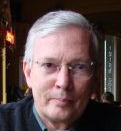When Rosemary Flannery invited me to join her for a guided walking tour to see the angels of Paris, I jumped at the chance. Rosemary is an expert on angels, having published a book on the subject.
The rendezvous point was set for place Saint-Michel, a popular square on the river between quai Saint-Michel and quai des Grands Augustins. The day was cold and drizzly, but the rain didn’t come down hard enough to keep me away. Nor did it chase away other people who gathered there for one reason or another. Soon the square was abuzz with different groups milling about.

Rosemary Flannery
Photography by www.DiscoverParis.net
Rosemary showed up, looking lovely in her red jacket.

Adrian Leeds
Photography by www.DiscoverParis.net
Adrian Leeds showed up carrying a red umbrella. No shrinking violet she! A woman who wears many hats, including the beret that she dons for style and for warmth, she is president of The Adrian Leeds Group.

Rosemary Begins Her Presentation
Photography by www.DiscoverParis.net
Another person showed up (on the right in the photo above), but she had to dash off soon after. That left us as a group of three, Rosemary, Adrian, and me.

Rosemary at Place Saint-Michel
Photograph by www.DiscoverParis.net
Rosemary talked about Michel, the Archangel who defeated Lucifer in a mighty battle and cast him out of Heaven. Attached to Michel’s back are enormous wings befitting a powerful angel, while Lucifer displays only tiny bat-like wings affixed to his shoulder blades. The sculptural group by Francisque Duret was created to embellish this square, which was built by architect Gabriel Davioud in 1860 during the era of Baron Haussmann’s renovation of Paris.

Entrance to the Mansion of Isaac de Laffemas
Photograph by www.DiscoverParis.net

Rosemary and Adrian Admire Angel on the Doorway to the House of Isaac de Laffemans
Photograph by www.DiscoverParis.net
Our next stop was on rue Saint-Julien-le-Pauvre, where we admired the pediment over the entrance to the house of Isaac de Laffemans. One of the most despised public figures of the 17th century, de Laffemans served as the Civil and Criminal Lieutenant of the Provost of Paris, administering “justice” to the enemies of anyone suspected of plotting against Louis XIII. The pediment displays a chubby angel and a lounging woman in a low-cut gown, who swings the scales of justice to and fro, apparently with the same insouciance that de Laffemans had for his victims.

Les Deux Palais Café
Photograph by www.DiscoverParis.net

Angels on Spire of Sainte-Chapelle
Photograph by www.DiscoverParis.net
We were feeling chilled, so we stopped for hot chocolate at Les Deux Palais, a café across the street from the Palace of Justice. While we warmed up, Rosemary talked about the angels of the spire of Sainte-Chapelle, a 13th-century gem of a church that stands next to the palace. She explained that there are eight angels, four of which hold instruments of the Passion. They are interspersed with four angel musicians blowing long trumpets.

Rosemary Gestures toward the Tour de l’Horloge
Photograph by www.DiscoverParis.net
We left the café and stopped just a block away to admire the Tour de l’Horloge. Constructed in the 14th century at the behest of Charles V, the face of the clock displays a duo of angels bearing the royal shield.

Matthew the Evangelist as Angel on Tour Saint-Jacques
Photograph by www.DiscoverParis.net

Looking at Angels on Saint-Jacques Tower
Photograph by www.DiscoverParis.net
At the corner of avenue de Victoria and boulevard de Sébastopol, we looked up to see the Tower of Saint-Jacques rising high above. Rosemary pointed out an angel who represents Matthew, one of the four evangelists of the New Testament. The tower was built as a bell tower for a church named Église Saint-Jacques-de-la-Boucherie, whose parishioners were the butchers of the central market place that once existed nearby. The church was dismantled during the Revolution, but somehow its tower was preserved. Today it soars gracefully into the Paris sky!

Rosemary on Rue de la Verrerie
Photograph by www.DiscoverParis.net
Rue de la Verrerie was our penultimate stop. Rosemary called our attention to two angels sitting on the molding of the façade of the Saint Merry Church presbytery. Merry, a nickname for Medericus, was a 7th century abbot who came to Paris to live as a hermit. Somehow, he got a church named after him. The angel on the left clutches a giant pair of keys in tribute to Peter, gatekeeper of Heaven, while the other holds an abbot’s staff. Between the angels, just below the molding, is a heart, an allusion to Medericus’s heart that was once conserved as a relic here until it disappeared during the Revolution.

Angels on Administrative Building at Place de l’Hôtel de Ville
Photograph by www.DiscoverParis.net
From rue de la Verrerie, we walked over to place de l’Hôtel de Ville where Rosemary pointed out a duo of mischievous-looking angels with fetching smiles posed above the sober facade of an administrative building. Between them, the angels present the Seal of Paris: a three-masted galleon floating along the wavy currents of the Seine. A patterned strip of fleur-de-lis decorates the top, while the shield is crowned by a circle of crenelated towers, evoking the medieval ring of fortifications that once surrounded the city.

Rosemary in front of the Carrousel at Place de l’Hôtel de Ville
Photograph by www.DiscoverParis.net
Rosemary was eager to show us other angels, but we had run out of time. It had been a fascinating morning learning about the angels of Paris!
Rosemary Flannery offers guided tours of Paris. Information about her services can be found at the following link: http://passport-to-paris.com/.
* * * * * * *Like our blog? Join us on
Facebook!









































